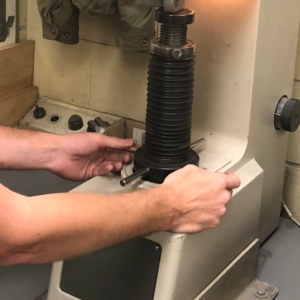Hardness Testing

Why Measure for Hardness?
Hardness testing measures the resistance of metals to plastic deformation by indentation. The table below lists the various tests, the indentor type, and the method of measurement.
Carbon steels and low Alloy steels show a good correlation between hardness and ultimate tensile strength. Hardness is a good indication of consistency and when correlated with the composition and heat treatment of cast ferrous and nonferrous Alloys it is a handy measure of the control and acceptability of castings. The low cost and simplicity of this kind of test leads to their use for a number of quality control applications.
Methods to Test Hardness
ASTM test methods are ASTM E 10 for Brinell hardness, ASTM E 18 for Rockwell hardness, and ASTM E 384 for Microindentional testing.
| Test | Indentor | Measurement |
|---|---|---|
| Brinell hardness | 10 mm tungsten carbide ball | Indentation diameter |
| ASTM E 10 Rockwell Hardness | 1/16” or 1/8” steel ball | Penetration depth |
| Diamond pyramid | conical brale diamond indentor | Ave. indentation diagonals |
| Vickers Hardness | diamond pyramid | Ave. indentation diagonals |
| Knoop Hardness | elongated diamond pyramid | Ave. indentation diagonals |

